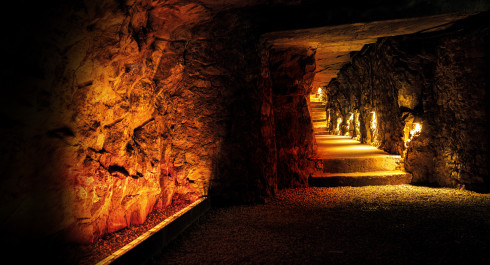
Luxembourg City Underground
Explore the depths of the city!
Take a deep dive into the city and discover the history of a little-known world, that of the casemates.
Luxembourg’s casemates are full of mystery. If they could speak, they would tell gloomy stories of long ago when Luxembourg was one of the most envied fortresses in Europe. Intimately linked to the cradle of the city of Luxembourg, the casemates’ immense underground military defence system came well after the foundation of the first stronghold, erected in the 10th century by Count Sigfried. While Luxembourg’s fortress stood for a veritable school of European military architecture, it has changed owners many times throughout its existence.
Italian, Spanish, Belgian, French, Austrian, Dutch and Prussian engineers took part in the gradual extension of the fortifications of this stronghold. The first casemates were built in 1644, under Spanish domination. The enlargement of the 23 km long underground galleries took place 40 years later, under the direction of the military engineer and fortifications builder Vauban, and later, in the 18th century, under that of the Austrians. The defence system extended over several storeys and comprised galleries carved out to a depth of 40 metres.
Due to these impressive bastions, the city of Luxembourg was deservedly called the “Gibraltar of the North”. In 1867, the fortress was evacuated and had to be dismantled following the neutralisation of Luxembourg. The dismantling lasted 16 years and the casemates were reduced to 17 km. Because of its underground location in the city, the network could never be destroyed without damaging a large part of the urban fabric. More than 1,300 plans relating to this enormous defensive network were found in the archives.
During the two world wars, the Bock Casemates and those of the Pétrusse valley served as a shelter with the capacity to protect 35,000 people in the event of an alert or bombardment. Since 1933, the two casemates have been open to the public. The bastions as well as the old town, which is of no less historical interest, enjoy worldwide renown. In 1994, UNESCO inscribed them on the list of World Heritage Sites.
Today the extraordinary network of underground galleries is the city’s prime attraction. Visitors plunge into the dazzling history of the inevitable casemates, which could shelter not only thousands of defenders with their equipment and horses, but also artillery and weapons workshops, kitchens, bakeries, slaughterhouses and other infrastructures.
What does the term “casemate” mean?
Casemate is derived etymologically from the Greek “chasma(ta)” meaning “chasm”. This is a “bomb-proof” vaulted room situated in the actual body of the works leading to one or more embrasures or intended to accommodate troops and equipment.



